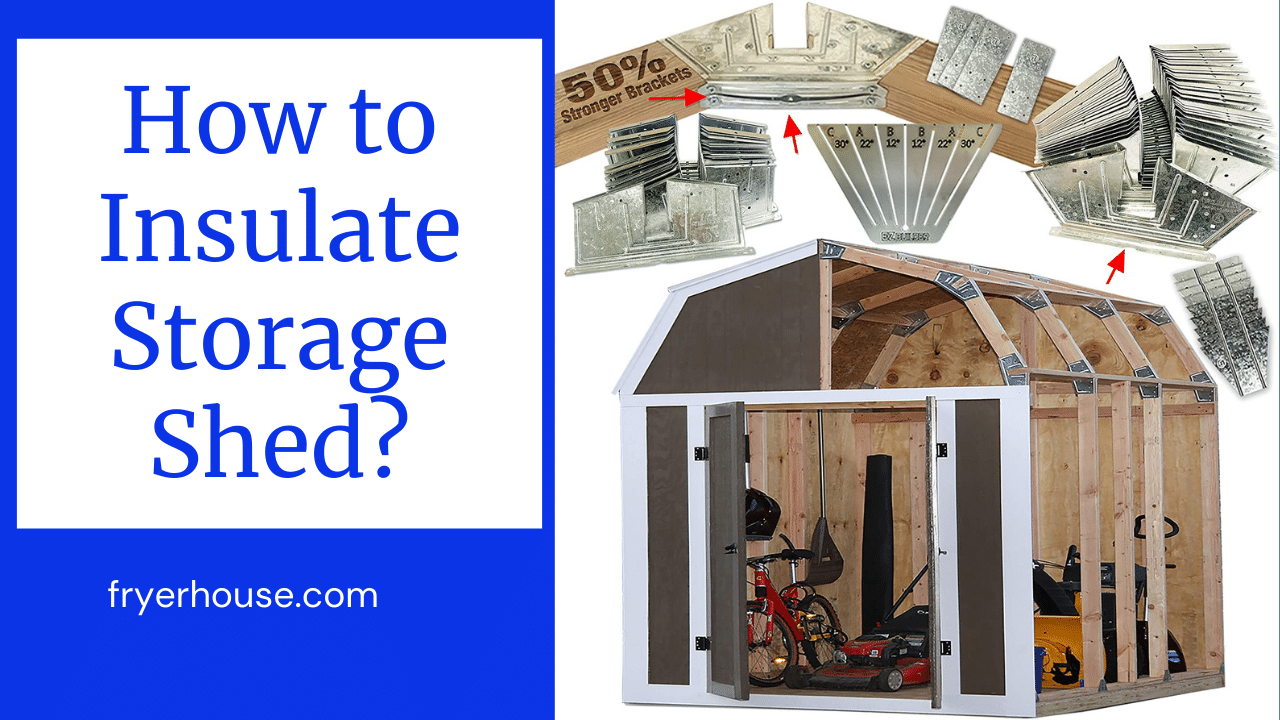Storage sheds require absolute care, whether you like it or not. You really need to be pertinent to the safety of the materials that you save in it. That would aid you also to preserve its essence.
Storage sheds can be of different materials; they can be of metals, plastics, or woods. Some have mixed features: some have their roofs made of rafters while some have theirs’ slant.
Seriously, there is none among them that you can’t insulate. All you just need is to identify the insulation that best suits the material your storage shed is made of. For those made of metals, we urge you to opt for rigid foam boards or spray foams.
However, for those made woods, it’s expedient that you check out the joisted parts of the shed and try fixing them up first. If possible, amend the ply and the whole (nooks and crannies) parts.
How to Insulate Storage Sheds? 7 Easy Steps
1. Get the Needed Materials Available
- You’ll need a batt sheet of estimated dimension and ply, MDF that you’d want to use as studs.
- You’d need a measuring tape.
- Chalk and a spacious patio won’t be a bad idea either.
- A seesaw and scissors may be required for cutting the ply and the weatherproof sheet/batting sheet after insulating.
- Get nails and a hammer; it will definitely be necessary to an extent.
- You can either get a professional or get ready-made insulating materials for an accessible alternative.
- Don’t forget a pencil and a book to jot down every piece of detail.
2. Measurements
It would be best if you use the tape rule to measure the dimension of your shed. Jot down every detail. Concentrate on the walls and the base. If you intend to house your pet in the storage shed, then insulating the underside is pretty a great idea.
Therefore, make sure that you get a partner during this time so that the whole activity will hassle-free. First, measure the length and breadth of every corner of your shed. It’s afterward that you can proceed to your workshop or bend down on your patio to get the work/planning started.
3. Cutting and Slotting
It’s time to cut the planks into studs. You’re getting some lined up horizontally while some others are vertically crossing the studs. You can now check the length of your walls and sketchily divide it evenly into squares.
Do that on every side of the walls, including those close to the door. Using a 2” by 4” plank is quite ideal. Now, cut as many as you can and nail them evenly and horizontally against the walls of your shed. Cut the pieces likewise.
You might even choose to use 4” by 8” planks for the horizontal and 2” by 4” for the vertical. You’ve already known how wide your wall is, and you can demarcate the wideness into phases.
4. Insertion of R-Value foam
There are highly valued R-value foams in the marketplace that you can order. However, we enjoin you to opt for wool insulation. Why?
That’s because it can withstand high temperatures. Having known the dimension of the phases you’ve demarcated the walls of your storage shed into, then cut the rigid foams into the same sizes so that they can snugly enter into those spaces.
You don’t have to press either the foam or the wool; that would depreciate its R-value. Instead, use a chisel or hammer to adjust the woods for the foams to enter into the phases comfortably.
5. Use the Batting Sheet
The interior layer of the batting sheet is an attractive part, and that should replace the external wall for you. So, roll out the batting sheet.
You can do that explicitly on the floor on your patio, or wherever. Get enough nails ready and your hammer because you’ll need them after using your scissors to cut the sheets.
Cut the batting sheet and paste each on every row at every wall from one to another throughout. Notwithstanding, knack the crown of every nail until it’s buried in the support wood. Make sure that the job is clean before you move others to the next.
6. Airtight the Roof
This depends on the type of roof you have. For rafters, insulation doesn’t seem easy for one person except if you you’re shielding flatly and overboard. But, then, you can use the wood to make demarcations just as you did to the walls.
Black thick nylons can insulate the top and likewise an excellent rigid insulation board. Nonetheless, let’s talk about shielding by running the plyboard or insulation board from one end to another. Run base wood on every angle and side in a square/rectangular shape, as the case may be.
Then fill in the spaces by firstly running parallel planks by hitting the tips of planks from one end to another. It’s after one has done the horizontal that one can attach the verticals in columns.
Afterward, one can run an insulated covering sheet to cover the top. Fixing foams is not mandatory; you can use an insulating sheet instead.
7. Precautions
- Making sure that the frames are leveled before fixing in the insulating foams makes the placement of batting sheets so lucid.
- It’s expedient that you take time to research and read this over and over again before you set out to execute the job.
- Ensure that your equipment is all reachable.
- Getting an insulated door for your storage shed makes the whole activities look pretty promising.
- Don’t forget to keep your workspace clean before and after use.
- If you use an insulating board or sheet, whatever it may be, ensure that you cut off the excess part at the end.
What is the easiest way to insulate a shed?
It is necessary to insulate your shed regardless of what you want to store in the shed. Without insulation, the weather will have adverse effects on the items in the shed. You can install a shed with bubble wrap, foam board, or fiberglass. Of all, the easiest and the most cost-effective method is the use of bubble wrap.
Make sure you plug all the gaps through which air can escape. This means that you need to carry out a thorough inspection before you start the insulation.
What is a good insulation material for a shed?
With proper insulation, you can convert your shed to a living room or a doghouse. It can also be converted to a workshop, workspace, or a home gym. We’ll be right to say that insulation makes your shed versatile. In addition, good insulation keeps moisture and its concomitant mold issues away.
Apart from mold, insects also breed in moist areas. Most of all, moisture hastens rot and deterioration. So, good insulation increases the lifespan of a shed. Finally, good insulation keeps the temperature in your shed stable and more consistent, to the benefit of the items stored in the shed.
First, you need to insulate the floor. This reduces heat loss via the floor by about 40%. In addition, you should apply the foam filler along the edges of the windows. This helps to block small gaps around the windows. Apply foam filler around the doors too. Wait for it to dry up before you cut off the excess foam filler.
Any type of insulation that prevents air from escaping outside the shed is good enough. What matters is regular inspection for gaps and holes.
Should I leave an air gap when insulating a shed?
No, you should not leave air gaps in your shed except if the content requires regular fresh air like firewood. As a matter of fact, what you want to keep in the shed will determine if you should leave air gaps or always block them. For instance, if you want to use the shed as a living room or the house of your pets, you shouldn’t leave any air gaps in it.
What is the cheapest insulation material?
The cheapest insulation material is bubble wrap, and it is also very effective. If applied properly, it will last for years. And if bubble wrap is not available, you can also use foam filler. Although foam filler is cost-effective, it is not as cheap as bubble wrap. As a rule of thumb, pick one of them and stick with it. Don’t mix them.
Can you insulate a plastic storage shed?
Yes, you can insulate plastic storage shed, but they don’t need as much insulation as wooden and metal sheds. This is because plastic sheds are usually well-insulated. It’s a metal shed that requires the most insulation because metal conducts heat, and the rate of heat loss through metals is very high.
One reason why you may want to buy a branded shed like a Rubbermaid is that they come with a certain level of insulation.

Final Verdict
Insulating storage sheds is a difficult task. However, you can save your time by hiring a PRO instead. But in case you intend to have fun in your garden/patio, then you can choose to learn how to insulate storage sheds. The points highlighted here are fundamentals that you can use. They are understandable and reliable to use for storage sheds of any kind.
- Make These 10 Delicious Appetizers in Your Air Fryer - September 22, 2023
- How to Cook Lamb Shoulder Chops in Air Fryer? - September 13, 2023
- How to Cook Crinkle Fries in Air Fryer? - September 13, 2023
